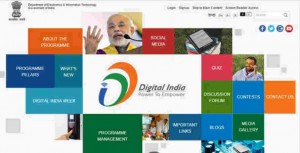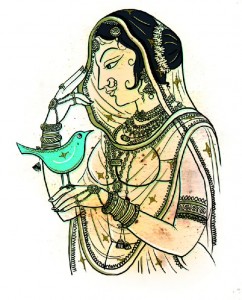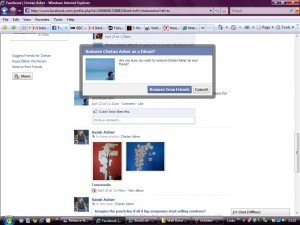“There ain’t no such thing as a free lunch,” was an adage that was popularised by economist Milton Friedman back in the 1960s. The core contention of the advice being that everything in life everything has a cost; be it upfront or hidden. But it is always there. Nothing is available for free.
Hence, when Facebook launched the Free Basics with much fanfare and excitement, presenting it as a do-goody social thingy, not everyone was able to swallow it. Not many, and not someone like me.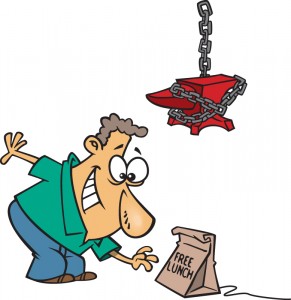
To be fair to Facebook, any corporate entity in the world exists only for one single purpose, namely, maximisation of shareholder’s value. This is the primary (and often, the only) reason why most company exists. Thus, if Facebook is trying to hook significant number of users that will join the cyberspace in the years to come, it is not something that we should hold against the company. After all, growing its numbers is the only way it can ensure its profitability in the days to come.
But sadly, that is not the way Free Basics is being promoted or pushed. By talking about the poor and the downtrodden, who can “at least, enjoy the limited and curtailed internet”, Facebook is sounding quite like those proselytising missionaries of yore, that would defend the harvesting of pagan souls, because at least they were better off now than before. By masking the whole program in the garb of philanthropy, Facebook has only put itself in the spot.
And then to make things worse, Facebook is now using its huge financial and marketing muscle to push things through. By some accounts, the “What’s on your mind?” company has earmarked some $20 million to promote (read educate) Free Basics in India. It is using all the mediums that are available for the battle, print, TV, digital, offline. Rather than having an open and fair discussions on finer aspects of net neutrality, Facebook is now seeming like those corrupt politicians who have been proven to be corrupt, but then try to correct their image by glitzy campaigns and doing some charity work.
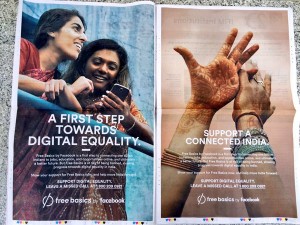 The reason that Mark Zuckerberg is going ballistic this time in India, is because of the manner in why Facebook had been splattered with a cake on its face, the last time round. In fact, it had been just some 6 odd months back when Free Basics in its earlier avatar as Internet.org faced immense resistance by the public at large, and thus was stalled by the Telecom Regulators. At that time, Facebook was taken aback by the power of the collective, by the sheer virality of things. So this time, it kind of came prepared, it repackaged the offering (giving it a kinder overtone), gave the offering an emotional spiel, had the creatives in place, and even Zuckerberg, who is on a paternity leave, is now writing blogs defending the offering. Continue reading
The reason that Mark Zuckerberg is going ballistic this time in India, is because of the manner in why Facebook had been splattered with a cake on its face, the last time round. In fact, it had been just some 6 odd months back when Free Basics in its earlier avatar as Internet.org faced immense resistance by the public at large, and thus was stalled by the Telecom Regulators. At that time, Facebook was taken aback by the power of the collective, by the sheer virality of things. So this time, it kind of came prepared, it repackaged the offering (giving it a kinder overtone), gave the offering an emotional spiel, had the creatives in place, and even Zuckerberg, who is on a paternity leave, is now writing blogs defending the offering. Continue reading

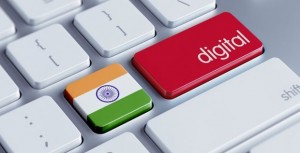 strength? And has she lost it completely? Does she represent anything vital now, apart from being the home of a vast number of human beings? How does she fit into the modern world?
strength? And has she lost it completely? Does she represent anything vital now, apart from being the home of a vast number of human beings? How does she fit into the modern world?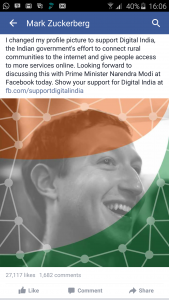 even the CEO of Facebook sporting a DP in support of Digital India. Google in the meantime announced that it will provide free Wi-Fi at 500 railway stations; Microsoft is planning to take broadband connectivity to 5 lakh villages. There is now so much excitement and so much euphoria around the idea, that one feels that there is nothing that can now come between us and our tryst with digitisation. No power on this planet can now stop us from being Digital India. Yeah! Yeah!
even the CEO of Facebook sporting a DP in support of Digital India. Google in the meantime announced that it will provide free Wi-Fi at 500 railway stations; Microsoft is planning to take broadband connectivity to 5 lakh villages. There is now so much excitement and so much euphoria around the idea, that one feels that there is nothing that can now come between us and our tryst with digitisation. No power on this planet can now stop us from being Digital India. Yeah! Yeah!